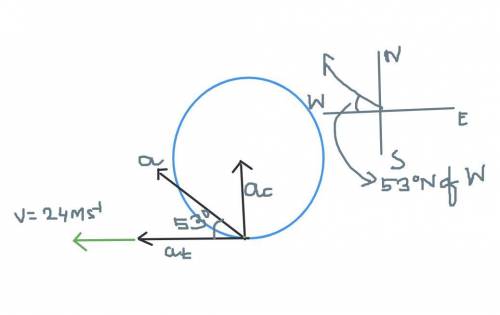
Physics, 16.04.2020 00:04 jahkin0256
A car travels in a flat circle of radius R. At a certain instant, the velocity of the car is 24 m/s west, and the total acceleration of the car is 2.5
m/s2, 53° north of west.
a) Find the radial and tangential components of the acceleration of the car at that moment.
b) If the car's tangential acceleration is constant, how long will it take for it to make one full circle from the point at which its velocity is 24m/s west?

Answers: 2
Another question on Physics

Physics, 22.06.2019 23:20
Acharge q experiences no net force at a particular point in space. which of the following situations described below must always be true? -there are no other charges nearby. -if there are other charges nearby, they must all have the same sign as q. -if there are other charges nearby, they must all have the opposite sign of q. -if there are other charges nearby, the total positive charge must equal the total negative charge. -none of the above
Answers: 2

Physics, 23.06.2019 00:50
A980-kg sports car collides into the rear end of a 2300-kg suv stopped at a red light. the bumpers lock, the brakes are locked, and the two cars skid forward 2.6m before stopping.the police officer, estimating the coefficient of kinetic friction between tires and road to be 0.80, calculates the speed of the sports car at impact. what was that speed?
Answers: 3

Physics, 23.06.2019 03:00
Which explanation most accurately describes convection within the ocean
Answers: 2

Physics, 23.06.2019 10:40
9. an object is moved from the outdoors, which is at a temperature of 100 ºf, to a room at a temperature of 70 º f. what happens to the object when it’s placed in the room with a lower temperature? the object gives off more energy than it absorbs until it reaches a new lower thermal equilibrium where the amount of energy absorbed and given off is the same. the object gives off the same amount of energy as it absorbs until it reaches a new lower thermal equilibrium where the amount of energy given off is greater than the amount of energy it absorbs. the object gives off more energy than it absorbs until it reaches a new higher thermal equilibrium where the amount of energy absorbed and given off is the same. the object absorbs more energy than it gives off until it reaches a new lower thermal equilibrium where the amount of energy absorbed and given off is the same.
Answers: 1
You know the right answer?
A car travels in a flat circle of radius R. At a certain instant, the velocity of the car is 24 m/s...
Questions

Mathematics, 05.03.2021 06:40




Mathematics, 05.03.2021 06:40

Mathematics, 05.03.2021 06:40

English, 05.03.2021 06:40

History, 05.03.2021 06:40

Mathematics, 05.03.2021 06:40

History, 05.03.2021 06:40



Physics, 05.03.2021 06:40

Mathematics, 05.03.2021 06:40






Mathematics, 05.03.2021 06:40

 and tangential
and tangential  components of acceleration of the car at that moment.
components of acceleration of the car at that moment. ⇒
⇒ 
 ⇒
⇒ 
 ⇒
⇒ 
 and
and  so,
so,
 ...equation (i)
...equation (i) ,
,  ,
,  ...
...




 where
where  ,
,  and
and 

 and
and 



